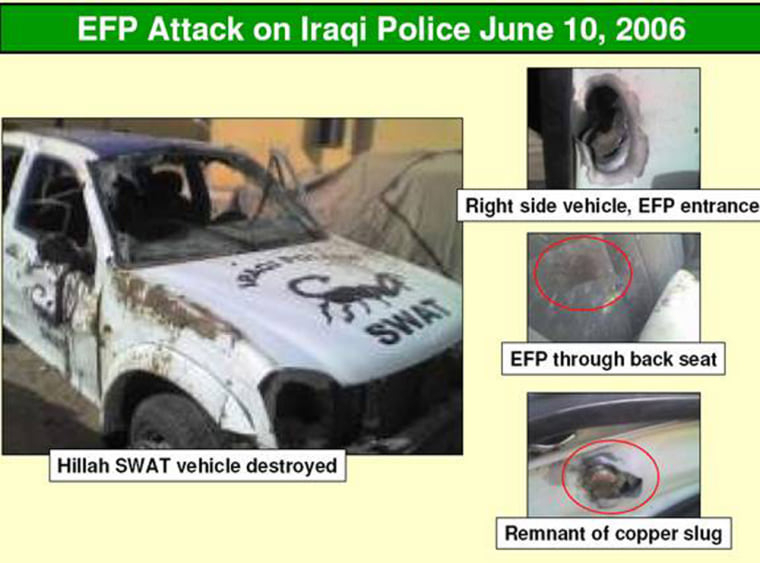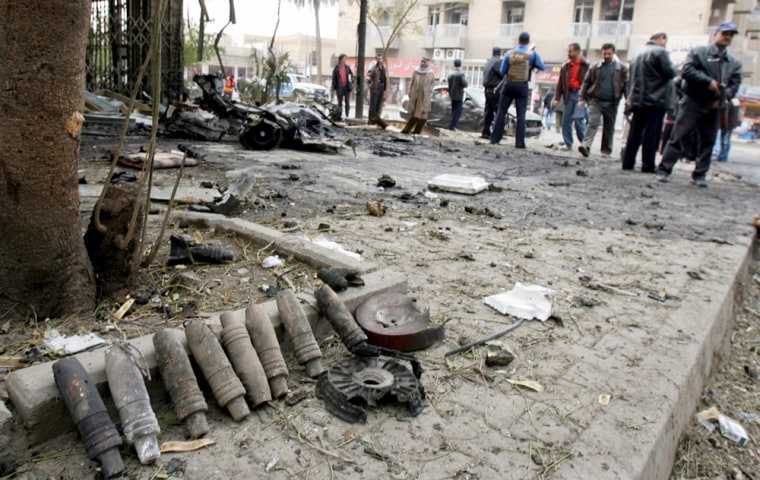U.S. military officials on Sunday accused the highest levels of the Iranian leadership of arming Shiite militants in Iraq with sophisticated armor-piercing roadside bombs that have killed more than 170 American forces.
The military command in Baghdad denied, however, that any newly smuggled Iranian weapons were behind the five U.S. military helicopter crashes since Jan. 20 — four that were shot out of the sky by insurgent gunfire.
A fifth crash has tentatively been blamed on mechanical failure. In the same period, two private security company helicopters also have crashed but the cause was unclear.
The deadly and highly sophisticated weapons the U.S. military said it traced to Iran are known as “explosively formed penetrators,” or EFPs.
The presentation was the result of weeks of preparation and revisions as U.S. officials put together a package of material to support the Bush administration’s claims of Iranian intercession on behalf of militant Iraqis fighting American forces.
Senior U.S. military officials in Baghdad said the display was prompted by the military’s concern for “force protection,” which, they said, was guaranteed under the United Nations resolution that authorizes American soldiers to be in Iraq.
‘Machining process’ laid to Iran
Three senior military officials who explained the display said the “machining process” used in the construction of the deadly bombs had been traced to Iran.
The experts, who spoke to a large gathering of reporters on condition that they not be further identified, said the supply trail began with Iran’s Revolutionary Guards Quds Force, which also is accused of arming the Hezbollah guerrilla army in Lebanon. The officials said the EFP weapon was first tested there.
The officials said the Revolutionary Guard and its Quds force report directly to Iran’s supreme leader, Ayatollah Ali Khamenei.
The briefing on Iran was revised heavily after officials decided it was not ready for release as planned last month.
Senior U.S. officials in Washington — cautious after the drubbing the administration took for the faulty intelligence leading to the 2003 Iraq invasion — had held back because they were unhappy with the original presentation.
The display appeared to be part of the White House drive that has empowered U.S. forces in Iraq to use all means to curb Iranian influence in the country, including killing Iranian agents.
It included a PowerPoint slide program and a handful of mortar shells and rocket-propelled grenades which the military officials said were made in Iran.
Anatomy of a weapon
The centerpiece of the display, however, was a gray metal pipe about 10 inches long and 6 inches in diameter, the exterior casing of what the military said was an EFP, the roadside bomb that shoots out fist-sized wads of nearly molten copper that can penetrate the armor on an Abrams tank.
“A normal roadside bomb is like a shotgun blast. But these are like a rifle. They’re focused and they’re aimed. ... It’s going to take anything out in its way, go in one side and out the other,” said 1st Lt. Zane Galvach, 25, of Dayton, Ohio, a soldier with the Army’s 2nd Division, based in Baghdad.
Skeptical congressional Democrats said the Bush administration should move cautiously before accusing Iran of fomenting a campaign of violence against U.S. troops in Iraq.
Senate Intelligence Committee member Ron Wyden, D-Ore., said “the administration is engaged in a drumbeat with Iran that is much like the drumbeat that they did with Iraq. We’re going to insist on accountability.”
Lott against Iran incursion
On the Republican side, Sen. Trent Lott of Mississippi said he did not think the United States was trying to make a case for attacking Iran. Lott said the U.S. should try to stop the flow of munitions through Iran to Iraq but that “you do that by interdiction ... you don’t do it by invasion.”
The EFPs, as well as Iranian-made mortar shells and rocket-propelled grenades, have been supplied to what the military officials termed “rogue elements” of the Mahdi Army militia of anti-American Shiite cleric Muqtada al-Sadr. He is a key backer of Shiite Prime Minister Nouri al-Maliki.
The U.S. officials glossed over armaments having reached the other major Shiite militia organization, the Badr Brigade. It is the military wing of Iraq’s most powerful Shiite political organization, the Supreme Council for the Islamic Revolution in Iraq, whose leaders also have close ties to the U.S.
Many key government figures and members of the Shiite political establishment have deep ties to Iran, having spent decades there in exile during Saddam Hussein’s rule. The Badr Brigade was formed and trained by Iran’s Revolutionary Guard.
An intelligence analyst in the group said Iran was working through “multiple surrogates” — mainly in the Mahdi Army — to smuggle the EFPs into Iraq. He said most of the components are entering the country at crossing points near Amarah, the Iranian border city of Meran and the Basra area of southern Iraq.
‘We know more than we can show’
The analyst said Iraq’s Shiite-led government had been briefed on Iran’s involvement and Iraqi officials had asked the Iranians to stop. Al-Maliki has said he told both the U.S. and Iran that he does not want his country turned into a proxy battlefield.
“We know more than we can show,” said one of the senior officials, when pressed for tangible evidence that the EFPs were made in Iran.
U.S. officials have alleged for years that weapons were entering the country from Iran but had until Sunday stopped short of alleging involvement by top Iranian leaders.

During the briefing, a senior defense official said that one of the six Iranians imprisoned in January in the northern city of Irbil was the operational commander of the Quds Force.
He was identified as Mohsin Chizari, who was apprehended after slipping back into Iraq after a 10-month absence, the officer said.
The Iranians were caught trying to flush documents down the toilet, he said. They had also tried to change their appearance by shaving their heads. Bags of their hair were found during the raid, he said.
The dates of manufacture on weapons found so far indicate they were made after fall of Saddam Hussein — mostly in 2006, the officials said.
Official: Copters are targets 100 times a month
In a separate briefing, Maj. Gen. Jim Simmons, deputy commander of Multinational Corps-Iraq, said that since December 2004, U.S. helicopter pilots have been shot at on average about 100 times a month and been hit on an average of 17 times in the same period.
He disclosed a previously unknown shootdown, a Blackhawk helicopter hit by small arms fire near the western city of Hit. The craft crash-landed but there were no casualties. Simmons was on board.
The major general said Iraqi militants are known to have SA-7, SA-14 and SA-16 shoulder-fired anti-aircraft missiles but none of the most recent five military crashes were caused by those weapons. He said some previous crashes had been a result of such missiles but would not elaborate.
North of Baghdad, a suicide truck bomber crashed into a police station, killing at least 30 policemen. A total of 76 people were killed or found dead across Iraq. The U.S. military said Sunday a soldier was shot and killed the day before in volatile Diyala province northeast of the capital. A second soldier was reported killed Sunday in western Baghdad.
